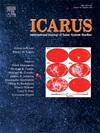基于电子对分布函数和ReaxFF分子动力学的“嫦娥五号”风化层撞击诱导铁矾石玻璃
IF 2.5
2区 物理与天体物理
Q2 ASTRONOMY & ASTROPHYSICS
引用次数: 0
摘要
撞击在月球的形成和演化中起着至关重要的作用。撞击引起的矿物相变对于理解撞击过程至关重要,例如橄榄石的非晶化。利用电子对分布函数和分子动力学模拟研究了嫦娥五号角砾岩中费雅丽石玻璃的形成机理。结果表明:fayalite玻璃是在压力释放过程中形成的,fayalite熔体淬火前温度为3200 ~ 3400 K,残余压力约为1 GPa;通过综合微观区域分析,结果表明,碰撞引起的颗粒破碎产生剪切表面,颗粒摩擦产生足够的热量,导致局部熔融,随后快速淬火产生玻璃。这项研究从微观角度研究了撞击玻璃的形成机制,增强了我们对太阳系撞击过程的理解。本文章由计算机程序翻译,如有差异,请以英文原文为准。
Impact-induced fayalite glass from Chang'e-5 regolith revealed by electron pair distribution function and ReaxFF molecular dynamics
Impacts play a vital role in lunar formation and evolution. The mineral phase transformations induced by impacts are crucial for understanding the impact processes, such as the amorphization of olivine. In this study, we investigated the formation mechanism of fayalite glass in Chang'e-5 breccia using the electron pair distribution function and molecular dynamics simulations. The results show that fayalite glass formed during pressure release, with temperatures ranging from 3200 to 3400 K before fayalite melt quenching and a residual pressure of around 1 GPa. By integrating micro-regional analyses, the results suggest that impact-induced particle fragmentation creates shear surfaces, where particle friction generates enough heat to cause local melting of fayalite, followed by rapid quenching to produce the glass. This study provides a microscopic perspective on the formation mechanism of impact glass, enhancing our understanding of the impact processes in the solar system.
求助全文
通过发布文献求助,成功后即可免费获取论文全文。
去求助
来源期刊

Icarus
地学天文-天文与天体物理
CiteScore
6.30
自引率
18.80%
发文量
356
审稿时长
2-4 weeks
期刊介绍:
Icarus is devoted to the publication of original contributions in the field of Solar System studies. Manuscripts reporting the results of new research - observational, experimental, or theoretical - concerning the astronomy, geology, meteorology, physics, chemistry, biology, and other scientific aspects of our Solar System or extrasolar systems are welcome. The journal generally does not publish papers devoted exclusively to the Sun, the Earth, celestial mechanics, meteoritics, or astrophysics. Icarus does not publish papers that provide "improved" versions of Bode''s law, or other numerical relations, without a sound physical basis. Icarus does not publish meeting announcements or general notices. Reviews, historical papers, and manuscripts describing spacecraft instrumentation may be considered, but only with prior approval of the editor. An entire issue of the journal is occasionally devoted to a single subject, usually arising from a conference on the same topic. The language of publication is English. American or British usage is accepted, but not a mixture of these.
 求助内容:
求助内容: 应助结果提醒方式:
应助结果提醒方式:


